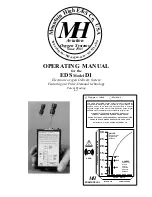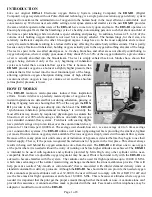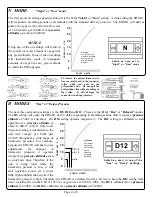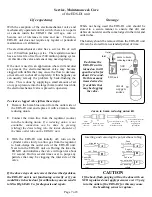
Page 7 of 8
Service, Maintenance & Care
of the EDS-D1 unit
Life expectancy
With the exception of the electromechanical valve and
mechanically operated control switch, there are no parts
or sensors inside the EDS-D1 that will age, cure or
become out of tolerance in time and use. Therefore,
EDS-D1 unit does not require any regular or periodical
maintenance or calibration.
The electromechanical valve has a service life of well
over 150 million pulsing cycles. The respiration sensor
has a service life of well over 500 million pulsing cycles.
At this time the valve and sensor may need replacing.
If the unit is used in an application where dirt and dust
are present, the electromechanical valve may become
clogged with debris that may cause the flow to decrease
or not allow it to shut off completely. If this happens you
can usually remedy the problem by back-flushing the
valve. This is done by supplying a small amount of air
or oxygen pressure into the large (6mm) outlet line while
the electromechanical valve is placed in open state.
To clear a clogged valve follow these steps:
1
Remove the 6mm blue union from the outlet side of
the EDS-D1 unit and replace it with a 4mm to 6mm
reducing union.
2. Connect the 4mm line from the regulator (source)
into the reducing union. If a reducing union is not
available, connection can be done by pressing
(sliding) the 4mm tubing into the inside diameter of
the 6mm outlet tube on the EDS-D1 unit.
2
With the EDS-D1 unit initially off, turn on the
cylinder valve slowly to allow gas from the regulator
to back-charge the outlet side of the EDS-D1 unit.
Next turn the EDS-D1 unit on. During the time the
EDS-D1 unit initializes the valve will open for about
1/2 second. Do this several times over to purge any
particles that may be clogging the inlet side of the
valve.
If the above steps do not correct the described problem,
the EDS-D1 unit is not functioning correctly or if you
would like it checked out for calibration you can send it
to Mtn. High E&S Co. for diagnosis and repair.
Stowage
While not being used the EDS-D1 unit should be
stored in a secure manner to ensure that dirt and
debris do not enter and become lodged in the inlet and
outlet tubes.
The battery should be removed from the EDS-D1 unit
if it is to be stored for an extended period of time.
CAUTION
If the back-flush purging will not be done with an
XCR regulator do not apply pressures over 35 psig
into the outlet of the EDS-D1 for this may cause
the breathing sensor to rupture.
A
B
C
A
B
C
Align tube
Push
Push tube
f i r m l y
Push
f i r m l y
Push in
collets
Pull tube
out while
pushing
collets
in about
1 cm.
Inserting and removing the polyurethane tubing
4mm.
polyurethane
tube end
Reducing Union
4mm. to 6 mm.
3cm. long 6mm. wide
polyurethane
interconnector tube
User supplied (soft type)
tubing. 1/8" I.D.
polypropylene,
polyethylene.
6mm to 4mm
reducing union
Outlet
Inlet
EDS unit
XCR
regulator
Air or
oxygen
source
Each time the
EDS-D1 unit is
turned on it will
open the valve for
about 1/2 second.
Do this as many
times desired to
free debris that
may be clogging
the valve
.
4 mm. to 6 mm. reducing union kit






























